CTRC Breakthroughs
Microscale Transport and Microchannels
Research Topics
Microscale Transport and Microchannels
Electrically Actuated Microscale Flows
Thin-Film Transport, Wicks and Heat Pipes
Novel Air and Impingement Cooling Approaches
Surface and Interface Engineering
Thermal Materials R&D
Thermal Interfaces
Small-Scale Refrigeration
Exploratory and Novel Concepts
Renewable and Sustainable Energy
Design Optimization of 3D Printed Microchannel Heat Sinks
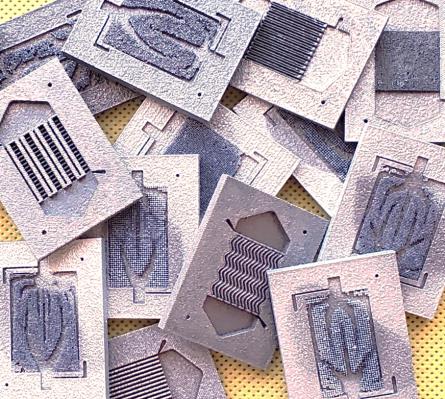 Additive manufacturing (AM) technology has the potential to produce compact heat sinks for
high-power cooling applications with geometric feature complexity beyond those fabricated by
conventional methods. In the pursuit of a design approach
that does not rely on design intuition, we have explored
topology optimization, a mathematical algorithm capable of
generating parts with complex features. A topology
optimization design tool was developed using a novel
homogenization approach. The topologically optimized
designs showed significant performance improvements in
managing power maps that include local hotspots. A series
of topologically optimized designs were fabricated using
DMLS and experimentally evaluated.
Additive manufacturing (AM) technology has the potential to produce compact heat sinks for
high-power cooling applications with geometric feature complexity beyond those fabricated by
conventional methods. In the pursuit of a design approach
that does not rely on design intuition, we have explored
topology optimization, a mathematical algorithm capable of
generating parts with complex features. A topology
optimization design tool was developed using a novel
homogenization approach. The topologically optimized
designs showed significant performance improvements in
managing power maps that include local hotspots. A series
of topologically optimized designs were fabricated using
DMLS and experimentally evaluated.
Evaluation of 3D Printing Technologies for Microchannel Heat Sinks
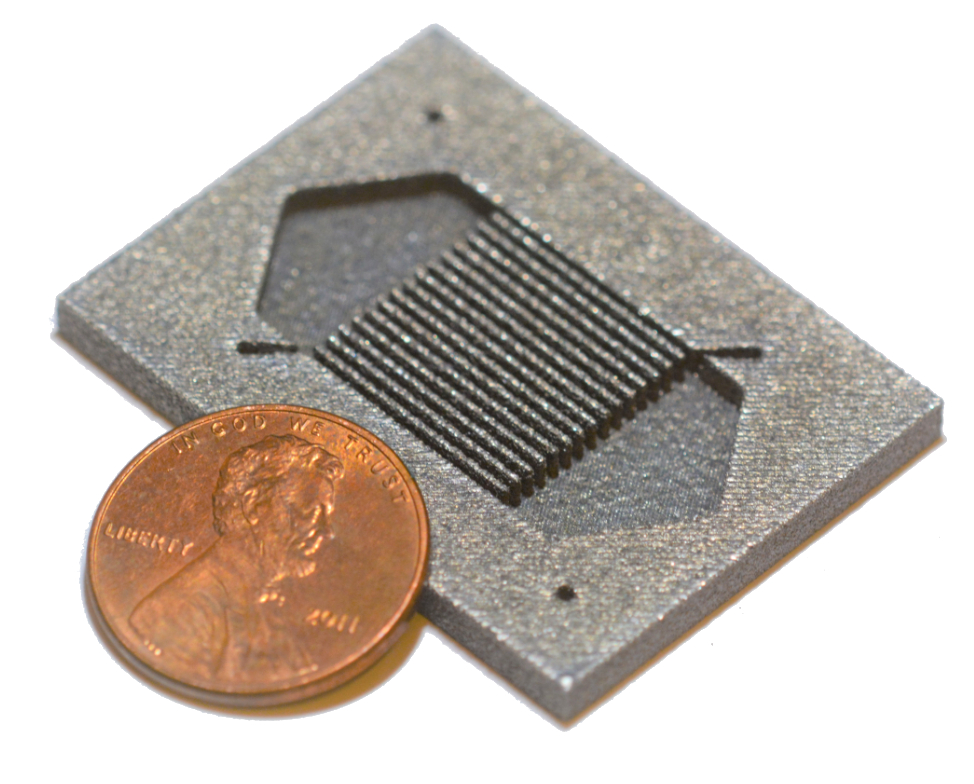 This project aims to develop new heat sink topologies that take advantage
of additive manufacturing capabilities to demonstrate enhancement performance. A novel, permeable
membrane microchannel (PMM) heat sink was designed and the performance compared to a
benchmark straight microchannel (SMC) heat sink. The PMM offers improved performance
when operating at a low pressure drop is a high priority. From am applications perspective, this
means that the PMM is preferred for large heater foot-print areas, small available heat sink
heights, high viscosity coolants, and at high flow rates. Additionally, the AM process was tuned
to fabricate smaller-than-achievable channel sizes compared to quoted machine capabilities,
which has potential performance benefits across any type of heat sink design. The outcomes of
this project will be leveraged in future work in the CTRC to achieve even higher performance
heat sink designs by implementing state-of-the art design and optimization methodologies that
further leverage the 3D printing technology.
This project aims to develop new heat sink topologies that take advantage
of additive manufacturing capabilities to demonstrate enhancement performance. A novel, permeable
membrane microchannel (PMM) heat sink was designed and the performance compared to a
benchmark straight microchannel (SMC) heat sink. The PMM offers improved performance
when operating at a low pressure drop is a high priority. From am applications perspective, this
means that the PMM is preferred for large heater foot-print areas, small available heat sink
heights, high viscosity coolants, and at high flow rates. Additionally, the AM process was tuned
to fabricate smaller-than-achievable channel sizes compared to quoted machine capabilities,
which has potential performance benefits across any type of heat sink design. The outcomes of
this project will be leveraged in future work in the CTRC to achieve even higher performance
heat sink designs by implementing state-of-the art design and optimization methodologies that
further leverage the 3D printing technology.
Investigation of Two-Phase Microchannel Flow Structures for Improved Predictive Models
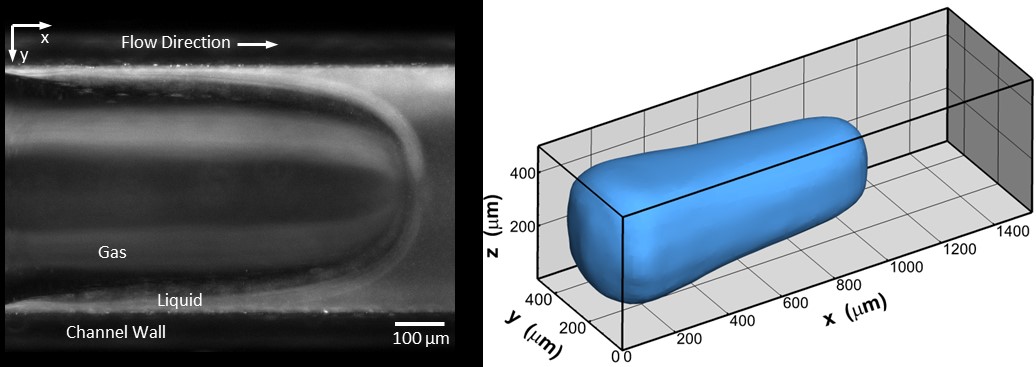 Multiphase microchannel heat sinks are an
attractive option for cooling of high power electronics due to
their compact size and high rate of heat extraction. One of
the limiting factors is the difficulty in predicting
performance, which hampers the design of application-specific
cooling systems. For this reason, it is desirable to develop
mechanistic models that capture the underlying physics of the
flow. By using optical microscopy in conjunction with advanced
image processing techniques, this project achieved the most
detailed characterization of liquid-gas interface structures
in a multiphase microchannel environment to date.
Additionally, parametric investigations into dependence of
interface shape on operating conditions within the annular
flow regime were conducted.
Multiphase microchannel heat sinks are an
attractive option for cooling of high power electronics due to
their compact size and high rate of heat extraction. One of
the limiting factors is the difficulty in predicting
performance, which hampers the design of application-specific
cooling systems. For this reason, it is desirable to develop
mechanistic models that capture the underlying physics of the
flow. By using optical microscopy in conjunction with advanced
image processing techniques, this project achieved the most
detailed characterization of liquid-gas interface structures
in a multiphase microchannel environment to date.
Additionally, parametric investigations into dependence of
interface shape on operating conditions within the annular
flow regime were conducted.
Effects of Non-Uniform Heating on Two-Phase Flow through Microchannels
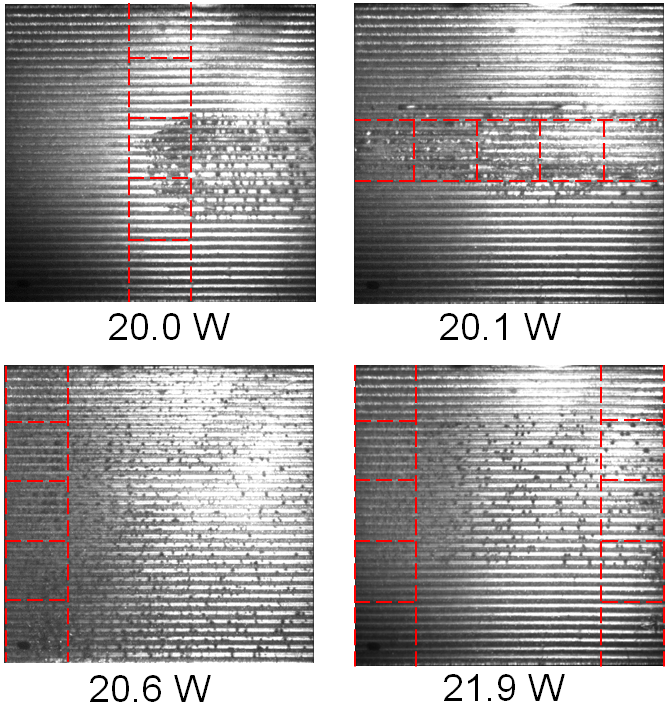 Understanding non-uniform heating effects on microchannel
cooling will enable better assessment of existing heat transfer
models for prediction of realistic non-uniform heating profiles
in any system. The developed simple computational model allows
for an easy analysis of different designs for cooling high-power
electronics. The results from this project enable the prediction
of realistic non-uniform heating profiles on any microchannel
heat sink. Images extracted from high-speed videos of four
different hotspot heating conditions. The total input power to
the microchannel heat sink is approximately the same in all
cases. The red lines indicate the heated area of the device and
the flow goes from left to right. Despite the same total power
applied to the heat sink, the location and degree of boiling is
different for each configuration.
Understanding non-uniform heating effects on microchannel
cooling will enable better assessment of existing heat transfer
models for prediction of realistic non-uniform heating profiles
in any system. The developed simple computational model allows
for an easy analysis of different designs for cooling high-power
electronics. The results from this project enable the prediction
of realistic non-uniform heating profiles on any microchannel
heat sink. Images extracted from high-speed videos of four
different hotspot heating conditions. The total input power to
the microchannel heat sink is approximately the same in all
cases. The red lines indicate the heated area of the device and
the flow goes from left to right. Despite the same total power
applied to the heat sink, the location and degree of boiling is
different for each configuration.
Thickness in Slug and Annular Flow for Heat Transfer Model
 This project developed a new three-dimensional measurement technique
applicable to boiling of coolant in microchannel heatsinks.
The novel, non-intrusive technique developed will allow for
investigations that were hitherto not possible in terms of
in-situ measurements in liquid-vapor phase-change
applications. The figure shows a 400 µm diameter capillary tube
and a fluorescent image of a planar cross section within the
tube.
This project developed a new three-dimensional measurement technique
applicable to boiling of coolant in microchannel heatsinks.
The novel, non-intrusive technique developed will allow for
investigations that were hitherto not possible in terms of
in-situ measurements in liquid-vapor phase-change
applications. The figure shows a 400 µm diameter capillary tube
and a fluorescent image of a planar cross section within the
tube.
Optimization of Manifold Microchannel Heatsinks
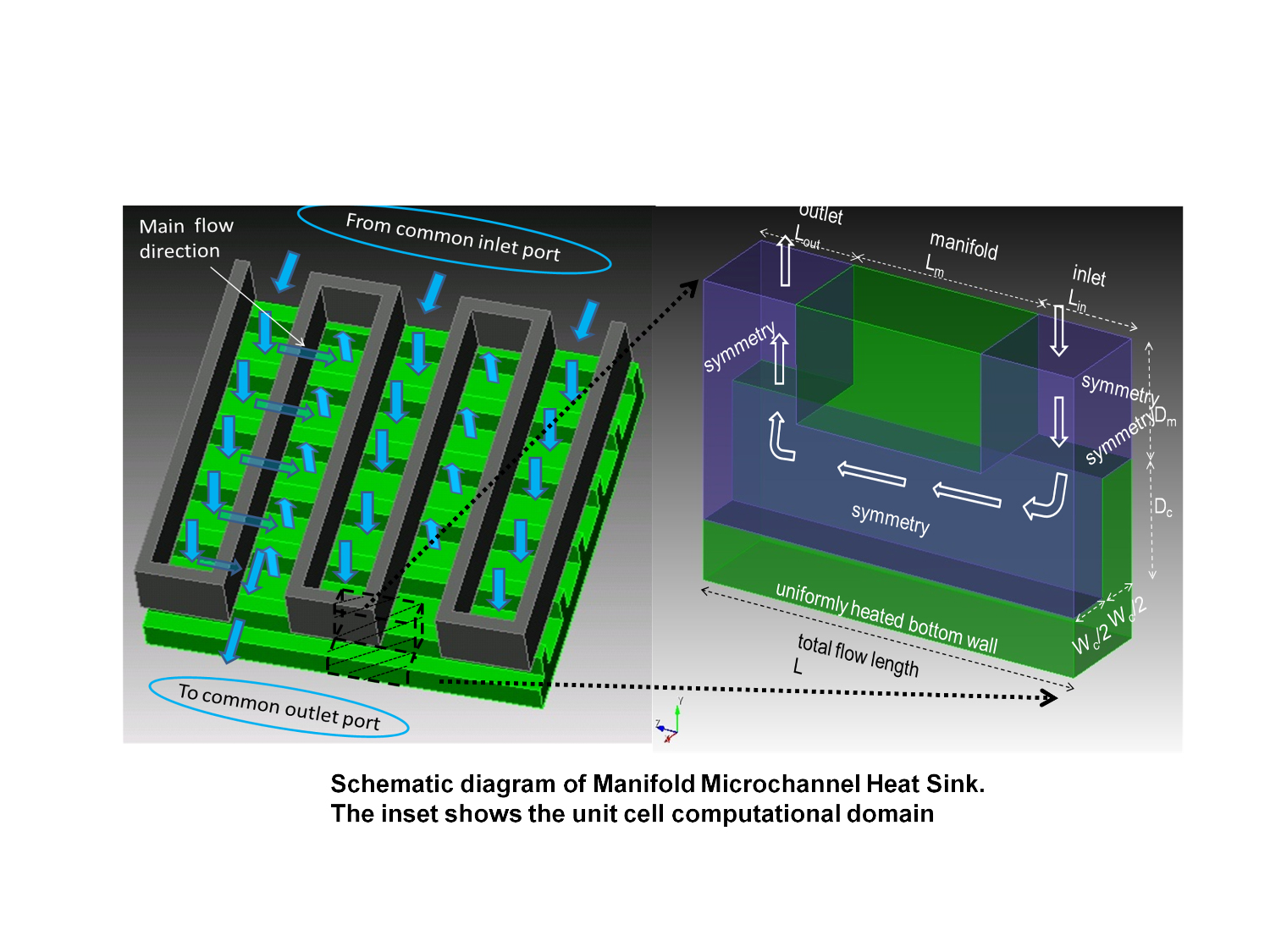 Deterministic
as well as probabilistic optimization is performed to arrive at
robust, reliable designs. Further, a response surface, capturing
the dependence of outputs on various inputs is developed, that
can be used as a cost-effective tool for future optimization
purposes. A porous medium model is also proposed to obtain the
system level probabilistic optimization at a reduced
computational cost. Manifold microchannel heat sinks involve the
use of a manifold system arranged in a transverse manner over
conventional microchannels, for distributing the flow through
multiple alternating inlet and exit pairs. Such an arrangement
leads to a reduction in the incurred pressure drop, while
improving the overall heat transfer performance. The
figure shows a schematic diagram of flow through a manifold
mcirochannel heat sink. The inset shows the unit cell
computational domain and boundary conditions used in present
study.
Deterministic
as well as probabilistic optimization is performed to arrive at
robust, reliable designs. Further, a response surface, capturing
the dependence of outputs on various inputs is developed, that
can be used as a cost-effective tool for future optimization
purposes. A porous medium model is also proposed to obtain the
system level probabilistic optimization at a reduced
computational cost. Manifold microchannel heat sinks involve the
use of a manifold system arranged in a transverse manner over
conventional microchannels, for distributing the flow through
multiple alternating inlet and exit pairs. Such an arrangement
leads to a reduction in the incurred pressure drop, while
improving the overall heat transfer performance. The
figure shows a schematic diagram of flow through a manifold
mcirochannel heat sink. The inset shows the unit cell
computational domain and boundary conditions used in present
study.
Flow Regime-Based Predictive Model for Flow Boiling in Microchannels
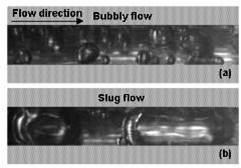 A
comprehensive understanding of flow boiling heat transfer and
pressure drop in microchannels for various liquid/surface
combinations, across a wide range of operating conditions, has
been developed. A large database of boiling flow pattern
visualizations is obtained for a wide range of channel
dimensions and flow parameters, leading to a good understanding
of microscale flow regimes. This gallery of visualizations has
been widely disseminated through the Cooling Technologies
Research Center website for researchers and practitioners
worldwide to use. The effects of microchannel geometry on flow
boiling and surface roughness on boiling heat transfer
enhancement has also been established. Based on the experimental
results, a new transition criterion is developed which predicts
the conditions under which microscale confinement effects are
exhibited in flow boiling. The figure shows a high-speed flow
visualization of bubbly flow and slug flow in 400
µm-wide microchannels
A
comprehensive understanding of flow boiling heat transfer and
pressure drop in microchannels for various liquid/surface
combinations, across a wide range of operating conditions, has
been developed. A large database of boiling flow pattern
visualizations is obtained for a wide range of channel
dimensions and flow parameters, leading to a good understanding
of microscale flow regimes. This gallery of visualizations has
been widely disseminated through the Cooling Technologies
Research Center website for researchers and practitioners
worldwide to use. The effects of microchannel geometry on flow
boiling and surface roughness on boiling heat transfer
enhancement has also been established. Based on the experimental
results, a new transition criterion is developed which predicts
the conditions under which microscale confinement effects are
exhibited in flow boiling. The figure shows a high-speed flow
visualization of bubbly flow and slug flow in 400
µm-wide microchannels
Boiling Heat Transfer Enhancement in Microchannels Using Surface Treatment
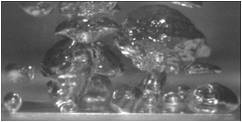 One
strategy for removing large amounts of heat in electronics is
the utilization of the highly effective heat transfer mechanisms
associated with the liquid-vapor phase change process. The
present work seeks to characterize and predict the enhancement
to boiling heat transfer provided by arbitrarily rough surfaces
in microchannel heat sinks. Results indicate that increasing the
surface roughness by a factor of 3 yields a 30% enhancement in
the amount of heat that can be removed while keeping the heat
sink temperature constant. Further increases in surface
roughness appear to be of little additional benefit. Boiling
from a flat, polished surface in a pool of water is shown in the
figure.
One
strategy for removing large amounts of heat in electronics is
the utilization of the highly effective heat transfer mechanisms
associated with the liquid-vapor phase change process. The
present work seeks to characterize and predict the enhancement
to boiling heat transfer provided by arbitrarily rough surfaces
in microchannel heat sinks. Results indicate that increasing the
surface roughness by a factor of 3 yields a 30% enhancement in
the amount of heat that can be removed while keeping the heat
sink temperature constant. Further increases in surface
roughness appear to be of little additional benefit. Boiling
from a flat, polished surface in a pool of water is shown in the
figure.
Two-Phase Transport in Microchannels
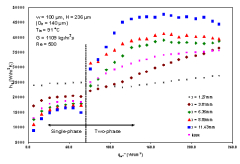 Transport
through microchannels that range in width from 100 to 400
micrometers in copper and silicon substrates is experimentally
characterized. Experiments include high-speed flow
visualization, and local and global temperature and pressure
measurements. A predictive model is also being formulated to aid
in the design and optimization of microchannel heat sinks.
Transport
through microchannels that range in width from 100 to 400
micrometers in copper and silicon substrates is experimentally
characterized. Experiments include high-speed flow
visualization, and local and global temperature and pressure
measurements. A predictive model is also being formulated to aid
in the design and optimization of microchannel heat sinks.



